Kristine Hughes's Blog, page 63
February 28, 2016
DO YOU KNOW ABOUT: JAMES LEES-MILNE?
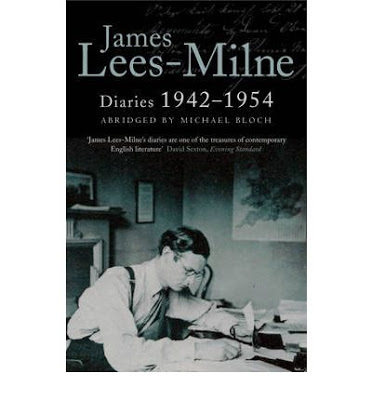
As some of you may already know, I am a great reader of British diaries, letters and journals. There are many such volumes on the shelves of my personal library. From Pepys to Queen Victoria, I adore the immediacy of these personal writings, the way they drop you right into the lives of their authors and introduce you in a very intimate manner to people, places and times otherwise vanished. Recently, I came across the diaries of James Lees-Milne, which had somehow managed to escape my notice over the past few decades. JML was in at the very beginnings of the National Trust and the Georgian Society, amongst other things, and was advisor to the National Trust on which properties should be purchased and preserved by that body. In this capacity, JML travelled around the UK, poking his nose into a variety of stately homes and writing down for posterity his views on their architectural merits, their contents and their owners, often with wit and sometimes with chagrin, but always in a way that can't help but to amuse the reader. In addition, JML lived in London and spent much of the 1930's and 1940's mixing with the Bright Young Things, various celebrities and writers and members of the Royal Family. No doubt you'll appreciate that all of this makes for great fodder in the diary of someone who had a keen observational eye and a talent for first person prose. To read more about the accomplishments of James Lees-Milne, you will find the 1997 obituary that ran in The Independent here.
You'll understand when I tell you that I was prepared to like these Diaries before I'd read Page 1, but I wasn't prepared to find that so many of the entries would resonate with me on a personal level.
Tuesday, 17th February, 1942
Dined with Harold Nicolson and Jamesey at Rules. We talked about Byron's sex life . . . .
Do you mean to say that other people sit around various London venues discussing the sex lives of dead people? Granted, in my circle we tend to focus on Brummell's sex life, but close enough, what? And then there's this entry -
Wednesday, 13th October, 1948
This evening I dined with the John Wyndhams. . . . After dinner, when the women left, talk was about how little we know of the everyday life of our ancestors in spite of George Trevalyan's history. Jock Colville suggested we ought to go home tonight and write down in minute detail how we drove to the Wyndham's door, left our car at the kerb, its doors firmly locked, rang the bell, were kept waiting on the doorstep, how we were received by a butler wearing black bow tie instead of white, what the hall smelt like, how the man took our coats and hats, putting them on a chest downstairs, and how he preceded us upstairs, one step at a time, etc., etc.
Positively uncanny. How often have myself and my friends, many of whom are writers of historical novels, lamented this very same thing and had almost the exact same discussion? By this time I was finding the diaries so delicious that I had to call Victoria immediately.
"Hello."
"Have you ever heard of James Lees-Milne? You must start reading him now. He's our new best friend. Where has he been all of our lives? How could either of us not known about his existence before now?"
"Who?"
"James Lees-Milne. The National Trust guy. Friends with everyone, including the Mitfords. He and his friends used to sit around discussing Byron's sex life."
"James who?"
"Hang up. I'm emailing you the link to his Diaries now. On Kindle. Buy them."
Of course, not all of the Diary entries are about such musings. As I've said, JML lived in London during this period and there is much to be found about the City, especially during wartime. Again, they resonated with me because much of JML's London incorporates my London, i.e. the areas and places in London that I revisit and in which I feel most at home.
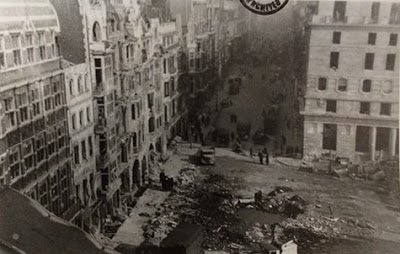
Bomb damage in Pall Mall/St James's Street, February 1944
Thursday, 24th February, 1944
There is no doubt our nerves are beginning to be frayed. Frank telephoned this morning. I could tell by his voice he was upset. He said he was going to leave the Paddington area and thought Chelsea or Belgravia would be safer. I said I doubted whether the Germans discriminated to that extent. This evening I went to see a crater in the road, now sealed off, in front of St. James's Palace. The Palace front sadly knocked about, the clock awry, the windows gaping, and shrapnel marks on the walls. A twisted car in the middle of the road. . . In King Street Willis's Rooms (Almack's) finally destroyed, one half having gone in the raid of (May) 1941 when I was sheltering in the Piccadilly Hotel.
Sunday, 18th June, 1944
At Mass at 11 there was a great noise of gunfire and a rocket. In the afternoon Stuart walked in and said that a rocket had landed on the Guards' Chapel (Wellington Barracks) during service this morning, totally demolishing it and killing enormous numbers of Guards officers and men. Now this did shake me. After dining at the Churchill Club we walked through Queen Anne's Gate, where a lot of windows with the old crinkly brown glass panes have been broken. In St. James's Park crowds of people were looking at the Guard's Chapel across Birdcage Walk, now roped off. I could see nothing but gaunt walls standing, and gaping windows. No roof at all. While I watched four stretcher-bearers carried a body under a blanket, a (air raid) siren went, and everyone scattered. I felt suddenly sick. Then a rage of fury against the war raged inside me. For sheer damnable devilry what could be worse than this terrible instrument?
To think that Gunter's and Almack's had managed to survive until the War. In fact, JML was a patron of Gunter's -
Saturday, 16th June, 1945
This morning the telephone man came to Alexander Place to say he would install my telephone on Monday . . . the bath however is still unattached to the pipes. The house painter and I picnic together. I leave the house each morning at 7.30 to bathe, shave and breakfast at Brooks's, where I virtually live. In Heywood's shop I met Diana (nee Mitford) Mosley and Evelyn Waugh with Nancy (Mitford). I kissed Diana who said the last time we met was when I stayed the night in Wootton Lodge, and we both wept when Edward VIII made his abdication broadcast. I remember it well, and Diana speaking in eggy-peggy to Tom Mosley over the telephone so as not to be overheard. . . . We all lunched together at Gunter's. . . .
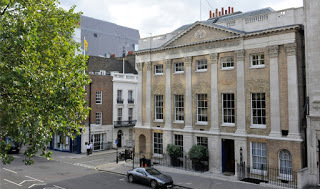 Brooks's Club, St. James's Street
Brooks's Club, St. James's StreetLees-Milne stirs the heartstrings of every Anglophile with this entry -
Saturday, 17th June, 1944
Worked in Brooks's library this afternoon. I am always happy in this stuffy, dingy Victorian library, in which the silence is accentuated by the relentless ticking of the old, stuffy clock.. I love the old stuffy books on the stuffy brown shelves, books which nobody reads except Eddie Marsh, and he falls fast asleep over them. The very atmosphere is calculated to send one asleep, but into the gentlest, most happy, nostalgic dreams of ninetheenth-century stability, self-satisfaction and promise of an eternity of heavenly stuffiness, world without end. How much I adore this library, and club, nobody knows. May it survive Hitler, Stalin and all the beastliness which besets us.
As I said, JML travelled the length and breadth of the UK both for his National Trust work and in order to visit various friends and relations. His entries concerning the Duke of Wellington were of particular interest, especially as they illustrate the consequences which the burden of caring for the first Duke's belongings could bring about -
Saturday, 15th April, 1944
I caught the 1.15 to Reading where Gerry Wellington met me at the station in his small car, for he gets twenty gallons a month for being a duke. . . the western front of Stratfied Saye house clearly shows it to date from Charles I's reign . . . . the east front is not so regular as the west, and the terraces are deformed by messy Edwardian flower beds. Gerry, who hates flowers, will soon have them away . . . Having eaten little luncheon I was famished, but tea consisted of only a few of the thinnest slices of bread and butter imaginable. After tea we did a tour of the inside of the house, beginning with the hall. When my stomach started to rumble with hunger Gerry looked at it with a reproachful air, and said nothing. It went on making the most awful noise like a horse's. The hall has a gallery along the wall opposite the entrance. The open balusters were boxed in so as to prevent the servants being seen from below by the visitors. Gerry's mother used to say that nothing of them was visible except their behinds, as they crouched and bobbed across the gallery. . . . the dining room is shut up, all the Apsley House pictures being stored there for the war, and valued at a million pounds, so G. says. . . . After dinner, at which there were no drinks except beer, (Gerry) showed me his grandfather's collection of gems and intaglios, mounted on long, gold chains. When held against the oil lights, some of the stones were very beautiful. G. is very fussy over the key bunches, everything being carefully locked up. He has a butler, cook and two housemaids, and a secretary, Miss Jones. The last has meals with him during the week, and nearly drives him mad with her archness. `Aren't you naughty today?' she says. She is unable to type, so when he wishes to dispatch a letter not written by himself, he types it and gives it to her to sign.
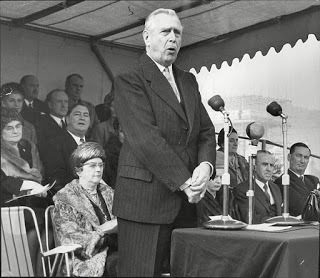 Gerald Wellesley, 7th Duke of Welligtonand
Gerald Wellesley, 7th Duke of WelligtonandSunday, 26th June, 1948 (at Stratfield Saye)
Lady Hudson and Lady Granville came to tea, and Lady G. suddenly developed St. Vitus's dance and jangled the cup in her saucer, spilling scalding tea through a thin silk dress on to her knees, and smashing the saucer to smithereens. Gerry leapt up, seized the table upon which a few drops of the tea had sprinkled and rushed away with it to have the surface polished. He made not a gesture of help or sympathy to poor Lady Granville who was in considerable pain and distress. Typical Gerry behaviour. He never lets one down. His patent anxieties about his possessions bring these catastrophes about . . . . .
Below are just three more examples of JML's entries on stately homes that afford us an insight onto a bygone way of life -
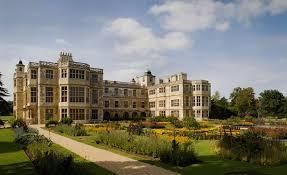
Thursday, 4th May, 1944
Martineau and I lunched at the Hyde Park Hotel with Lord Braybrooke, who has recently succeeded two cousins (killed on active service), inheriting the title and Audley End (House, Essex). He is a bald, common-sensical, very nice business man of 45, embarrassed by his inheritance. At his wit's end what to do with Audley End. Who wouldn't be? It was arranged that Martineau and I would visit the house with him in June. It is requisitioned by the Army and used for highly secret purposes, so that even he is not allowed into the rooms except in the company of a senior officer. Consequently he hardly knows the way round his own house. . . .
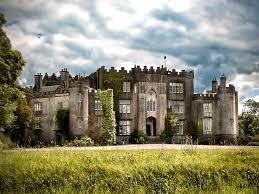
Saturday, 25th August, 1945
Describing a journey to Birr Castle - I woke at 5.45 and at 6.45 the car ordered by Michael Rosse called for me. It picked him up in Mount Street and drove us to Euston for the 8.15 to Holyhead. Travelled in comfort and ease. . . . After a smooth crossing we reached Kingstown at 7.30. I was at once struck by the old-fashioned air of everythng: horse-cabs on the quay, cobbled streets with delicious horse-droppings on them. Met by a taxi come all the way from Birr, for 8 pounds. Letter of greeting from Anne to Michael. Vodka for Michael and me in the car. We drove straight through Birr. Even through the closed windows of the car I caught the sweet smell of peat in the air. Curious scenes, ragged children on horses drawing old carts along country lanes. Our driver sounded his horn loudly through Birr, that pretty, piercing foreign horn. The gates of the castle shop open as if by magic. A group of people were clustered outside the gate. We swept up the drive. All the castle windows were alight, and there on the sweep was a large crowd of employeees and tenants gathered to welcome Michael home from the war. Anne, the two Parsons boys and Mr. Garvie the agent on the steps. Behind them Leavy the butler, the footman, housekeeper, and six or seven maids. A fire blazing in the library and everywhere immense vases of flowers. We heard Michael make a short speech from the steps, followed by cheers and `For he's a jolly good fellow,' a song which always makes me go hot and cold, mostly hot. The crowd then trooped off to a beano and drinks, while we sat down to a huge champagne supper at 11 o'clock.

Sunday, 1st August, 1948
Debo and Andrew (Hartington)(later 11th Duke and Duchess of Devonshire) drove me to Chatsworth this morning. The site of the house, the surroundings unsurpassed. The grass emerald green as in Ireland. The Derwent river, although so far below the house, which it reflects, seems to dominate it. Black and white cattle in great herds. . . . We wandered through the gardens, greyhounds streaming across the lawns. Andrew turned on the fountain from the willow tree. Water not only drips from the tree but jets from nozzles all round. The cascade not working this morning, but will be turned on for the public this afternoon. At present the great house is empty, under covers and dustsheets. Next year the state rooms are to be shown . . . As a couple the Hartingtons seem perfection - both young, handsome, and inspired to accomplish great things . . . Both full of faith in themselves and their responsibilities. She has all the Mitford virtues and none of the profanity. I admire them very much.
The Diaries are full of entries that shed light on the many facets to Lees-Milne's personality, from the profound -
Wednesday, 30th November, 1949 (upon the death of his father after a long illness)
The very worst thing about death are the disprespect, the vulgarity, the meanness. God should have arranged for dying people to disintegrate and disappear like a puff of smoke into the air. There are many other scraps of advice I could have given him.
to the stingingly comic -
Sunday, 14th November, 1948
Newman, the hall porter at Brooks's, told me I would be surprised if I knew which members, to his knowledge, stole newspapers out of the Club. I said, `You must not tell me,' so he promptly did.
I urge you, as I urged Victoria, to waste no time in securing yourself a copy of James Lees-Milne's Diaries. Victoria, I'm pleased to say, took my advice and read the Diaries - she loved them, too. Do let me know what you think when you're finished with them.
Published on February 28, 2016 23:30
February 26, 2016
POST TOUR: THE VICTORIA AND ALBERT MUSEUM
POST TOUR: THE VICTORIA AND ALBERT MUSEUM
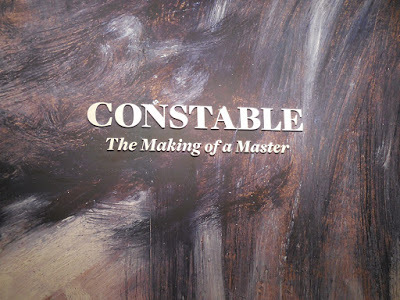
TO READ OUR ORIGINAL POST ON THIS TOPIC, CLICK HERE.
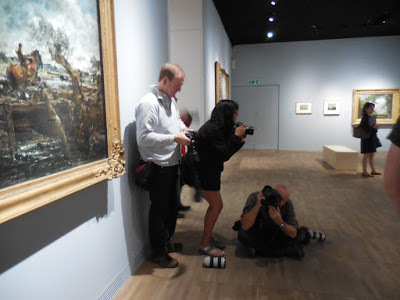 Press Opening of Constable Exhibit
Press Opening of Constable Exhibit
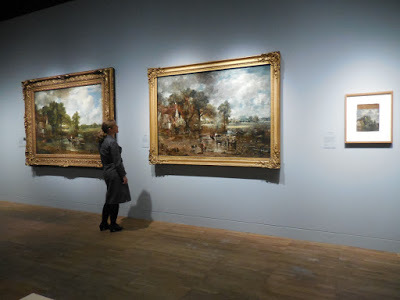
After we had our fill of Constable (as if that could ever happen!), we found lots of things to visit around the museum, lots more than we had time for. We started with coffee.
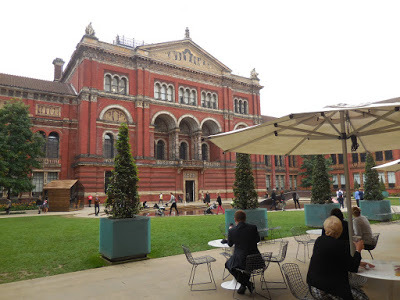 enjoying the outside in the courtyard
enjoying the outside in the courtyard
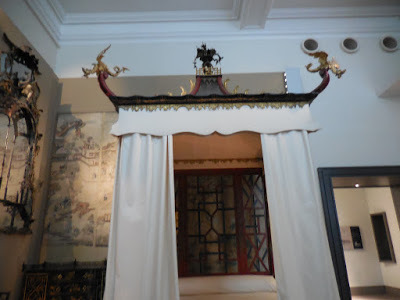 The Badminton Bed, 1754
The Badminton Bed, 1754
From Badminton House in Gloucestershire, the bed was designed by John Linnell and/or his brother William Linnell, and inspired by Chinese pagodas.The 4th Duke and particularly the Duchess of Beaufort were interested in the new craze for oriental works of art, and commissioned this bed for their home. A Copy of the Linnell bed is now in the house while the original is here in the museum.For pictures of the interior of Badminton House, click here. Scroll down to see the replica of the Badminton Bed.
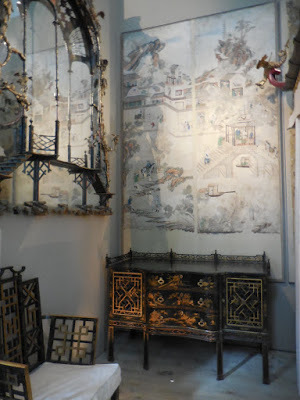 The Chinese Bedroom, from Badminton House
The Chinese Bedroom, from Badminton House
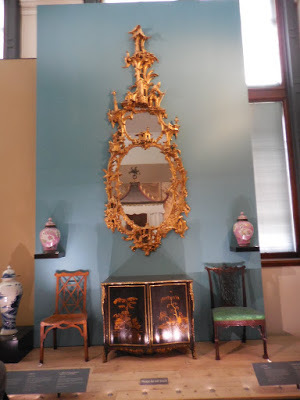 Chinoiserie display
Chinoiserie display
For more on chinoiserie at the V ad A, click here
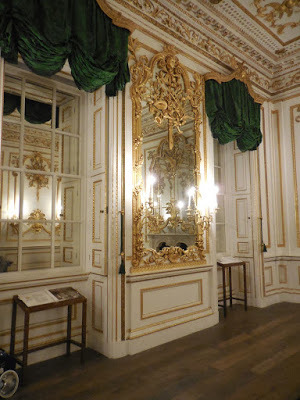 The paneling and doorways from Norfolk House at the Victoria and Albert Museum; it was the city home of the Dukes of Norfolk.
The paneling and doorways from Norfolk House at the Victoria and Albert Museum; it was the city home of the Dukes of Norfolk.
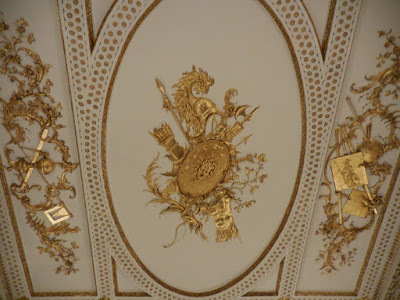 Ceiling from the Music Room of Norfolk House, 1756
Ceiling from the Music Room of Norfolk House, 1756
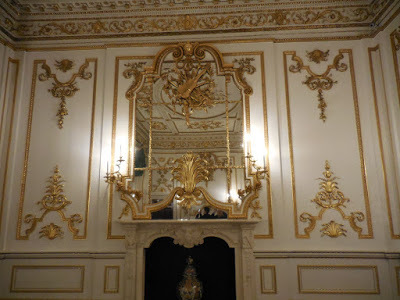 Norfolk House once stood in St. James's Square
Norfolk House once stood in St. James's Square
The house was demolished in 1938 after standing on the west side of St. James's Square since 1722. Most of the furnishings are now at Arundel Castle, home of the Dukes of Norfolk in West Sussex. For more information on the Music Room, click here.
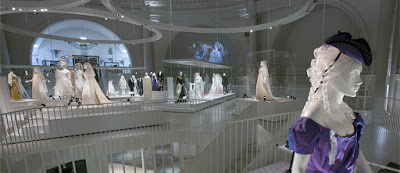 Wedding Dresses 1775-2014
Wedding Dresses 1775-2014
We were lucky enough to see the Wedding Dress from 1775-2014 Exhibition, at which no pictures were allowed.
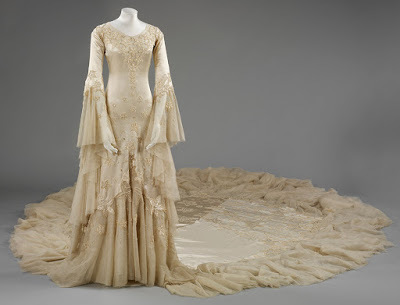 Silk satin wedding dress, designed by Norman Hartnell, 1933, Given and worn by Margaret, Duchess of Argyll. © Victoria and Albert Museum, London
Silk satin wedding dress, designed by Norman Hartnell, 1933, Given and worn by Margaret, Duchess of Argyll. © Victoria and Albert Museum, London
To read more about the exhibition, click here.
I never tire of visiting the V and A. It is overflowing with treasures of all kinds and full of excellent exhibitions from small to large. We had an afternoon appointment at Ben Franklin's House, so headed to Trafalgar Square.
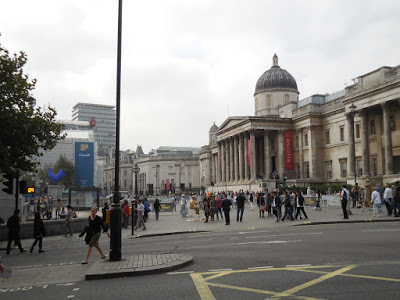
The blue rooster was the Fourth Plinth sculpture in 2014. Officially it was Hahn/Cock by Katharina Fritsch. It was replaced for the next 18-month stint on the Fourth Plinth by the politicially provocative Gift Horse by German-American artist Hans Haacke.
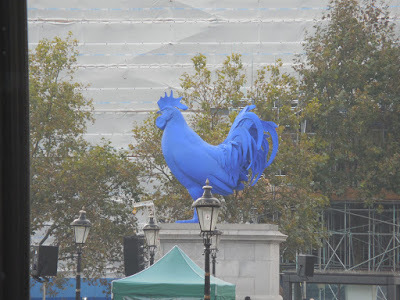
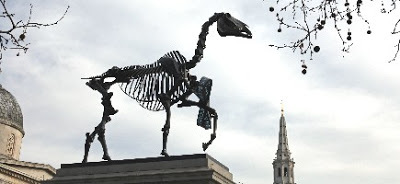 Photo from The Guardian
Photo from The Guardian
The skeleton in bronze has a stock-market ticker around its neck, So is it a symbol of Britain's lagging economy? Or a more robust interpretation of one of the healthiest economies in Europe, in the view of London Mayor Boris Johnson?
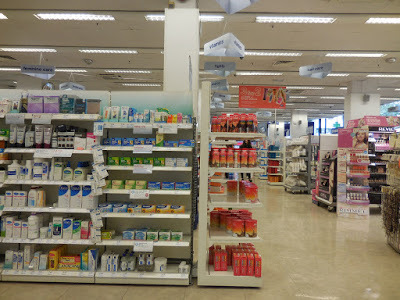 Boots
Boots
It is only fair that we acknowledge the heroic efforts of Kristine to overcome her misery. Thus, frequent stops at Boots!
 All the warnings are posted!
All the warnings are posted!
Next stop just had to be a pub! More on our adventures with Sherlock Holmes in an upcoming post. Stay tuned.
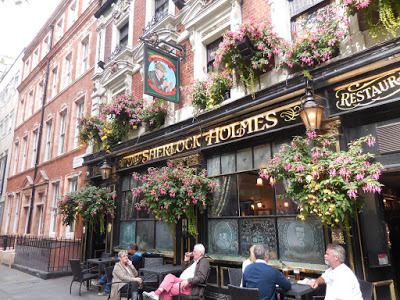
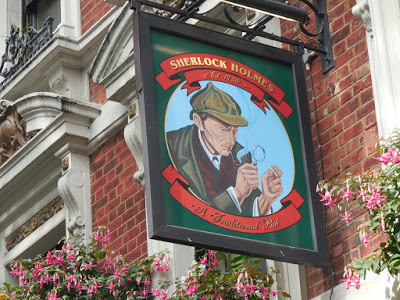

TO READ OUR ORIGINAL POST ON THIS TOPIC, CLICK HERE.
 Press Opening of Constable Exhibit
Press Opening of Constable Exhibit
After we had our fill of Constable (as if that could ever happen!), we found lots of things to visit around the museum, lots more than we had time for. We started with coffee.
 enjoying the outside in the courtyard
enjoying the outside in the courtyard The Badminton Bed, 1754
The Badminton Bed, 1754From Badminton House in Gloucestershire, the bed was designed by John Linnell and/or his brother William Linnell, and inspired by Chinese pagodas.The 4th Duke and particularly the Duchess of Beaufort were interested in the new craze for oriental works of art, and commissioned this bed for their home. A Copy of the Linnell bed is now in the house while the original is here in the museum.For pictures of the interior of Badminton House, click here. Scroll down to see the replica of the Badminton Bed.
 The Chinese Bedroom, from Badminton House
The Chinese Bedroom, from Badminton House Chinoiserie display
Chinoiserie displayFor more on chinoiserie at the V ad A, click here
 The paneling and doorways from Norfolk House at the Victoria and Albert Museum; it was the city home of the Dukes of Norfolk.
The paneling and doorways from Norfolk House at the Victoria and Albert Museum; it was the city home of the Dukes of Norfolk.  Ceiling from the Music Room of Norfolk House, 1756
Ceiling from the Music Room of Norfolk House, 1756 Norfolk House once stood in St. James's Square
Norfolk House once stood in St. James's SquareThe house was demolished in 1938 after standing on the west side of St. James's Square since 1722. Most of the furnishings are now at Arundel Castle, home of the Dukes of Norfolk in West Sussex. For more information on the Music Room, click here.
 Wedding Dresses 1775-2014
Wedding Dresses 1775-2014We were lucky enough to see the Wedding Dress from 1775-2014 Exhibition, at which no pictures were allowed.
 Silk satin wedding dress, designed by Norman Hartnell, 1933, Given and worn by Margaret, Duchess of Argyll. © Victoria and Albert Museum, London
Silk satin wedding dress, designed by Norman Hartnell, 1933, Given and worn by Margaret, Duchess of Argyll. © Victoria and Albert Museum, LondonTo read more about the exhibition, click here.
I never tire of visiting the V and A. It is overflowing with treasures of all kinds and full of excellent exhibitions from small to large. We had an afternoon appointment at Ben Franklin's House, so headed to Trafalgar Square.

The blue rooster was the Fourth Plinth sculpture in 2014. Officially it was Hahn/Cock by Katharina Fritsch. It was replaced for the next 18-month stint on the Fourth Plinth by the politicially provocative Gift Horse by German-American artist Hans Haacke.

 Photo from The Guardian
Photo from The GuardianThe skeleton in bronze has a stock-market ticker around its neck, So is it a symbol of Britain's lagging economy? Or a more robust interpretation of one of the healthiest economies in Europe, in the view of London Mayor Boris Johnson?
 Boots
BootsIt is only fair that we acknowledge the heroic efforts of Kristine to overcome her misery. Thus, frequent stops at Boots!
 All the warnings are posted!
All the warnings are posted!Next stop just had to be a pub! More on our adventures with Sherlock Holmes in an upcoming post. Stay tuned.


Published on February 26, 2016 00:00
February 23, 2016
REGENCY SCENTS BY GUEST BLOGGER MICHELLE STYLES
Originally published April 2008
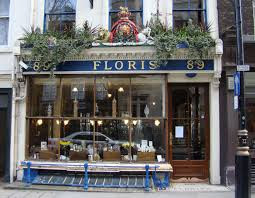
One of the delights of living in England is discovering how much survives from the Regency period (and in some cases before). I first came across Floris after reading an article about the men's clothing shop Hackett. Floris is a perfumery on JermynStreet and has occupied no 89 for about 250 years at least. It remains family run and the current head, John Bodenham is an 8th generation descendant of the founder Juan Famenias Floris. Floris was founded in 1730 and the shop has a small museum full of scent bottles and combs that I go and look at every time I am in London. The shop is lovely -- all glass and mirrors with wonderful scents. The Spanish mahogany cases were acquired in 1851 from the Great Exhibition. However, I was never that sure when a particular scent was created. I simply knew that I liked them. Stephanotis is beautiful and I fell in love with Malmaison earlier this year. Their Lily of the Valley is heavenly. And my dd adores Edwardian Bouquet. And to the wearer of particular scent, that is all that matters.
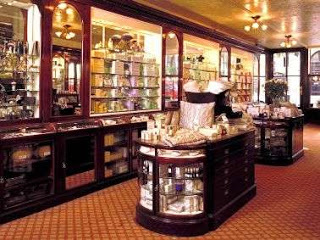
But when were the scents developed? And can I use them in my books? What were people in the Regency period actually wearing. Recently the Floris catalogue has been giving details about its scents and when they were developed.
Lily of the Valley was developed about 250 years ago. So say around 1758 -- making it a Georgian scent. Its top notes are green and lemon with heart notes of jasmine, lily of the valley,rose and tuberose. The base note is musk. Another Georgian scent Floris does is Limes and that was developed in the late 1700s to combat the awful smells and heat of the London summer.
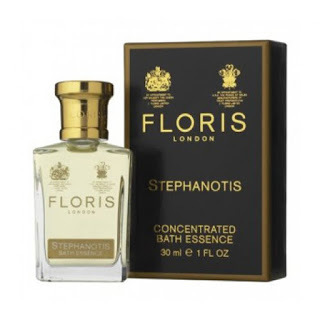
Stephanotis was developed in 1796 by the son of the founder -- James Floris. It combines the scents of the traditional bridal bouquet and was made because James Floris noticed how many brides were getting in and around St James. So what the Regency society bride might have worn. And it is truly lovely -- top note orange blossom, heart notes of carnation, coriander, lily of the valley, stenphanotis, jasmine with base notes of musk, powdery notes and sandalwood. In the flower language that was popular at the time, stephanotis means good luck. Another Regency fragrance is the Night Jasmine scent that was inspired by the jasmine scent that John Floris created in 1806. The floral design imprinted on their soaps dates from the early 19th century.
Malmaison is late 19th century by the way and is based on the Malmaison carnation, one of the more fashionable flowers of the late Victorian period. Apparently Oscar Wilde used to wear Malmaison carnations. The Malmaison scent is far heavier than the Stephanotis or Lily of the Valley. Top notes of cinnamon, cloves and lemon with heart notes of malmaison carnation, rose ,ylang and base notes of cedarwood, musk, patchoui, and vanilla. The Floris catalogue lists Malmaison under its classicfragrances -- suitable for either men or women. My dad's favourite Edwardian Bouquet dates from 1901 and was a celebration of the new era. It is a lovely floral scent.
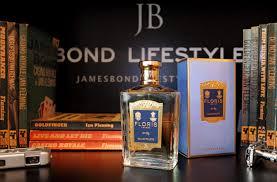
Anyway, it goes to show that a good scent can stand the test of time. And with its wide range of scents (Ian Fleming had James Bond wear no 89 for example) , there is a good reason why Floris is thriving today. But I thought I would toss out a few of the more historic scents in case people were interested. Floris does ship worldwide, but a visit to its shop in Jermyn Street should be a must for any one interested in the Georgian or Regency periods.
Please visit Michelle Styles's author blog here.

One of the delights of living in England is discovering how much survives from the Regency period (and in some cases before). I first came across Floris after reading an article about the men's clothing shop Hackett. Floris is a perfumery on JermynStreet and has occupied no 89 for about 250 years at least. It remains family run and the current head, John Bodenham is an 8th generation descendant of the founder Juan Famenias Floris. Floris was founded in 1730 and the shop has a small museum full of scent bottles and combs that I go and look at every time I am in London. The shop is lovely -- all glass and mirrors with wonderful scents. The Spanish mahogany cases were acquired in 1851 from the Great Exhibition. However, I was never that sure when a particular scent was created. I simply knew that I liked them. Stephanotis is beautiful and I fell in love with Malmaison earlier this year. Their Lily of the Valley is heavenly. And my dd adores Edwardian Bouquet. And to the wearer of particular scent, that is all that matters.

But when were the scents developed? And can I use them in my books? What were people in the Regency period actually wearing. Recently the Floris catalogue has been giving details about its scents and when they were developed.
Lily of the Valley was developed about 250 years ago. So say around 1758 -- making it a Georgian scent. Its top notes are green and lemon with heart notes of jasmine, lily of the valley,rose and tuberose. The base note is musk. Another Georgian scent Floris does is Limes and that was developed in the late 1700s to combat the awful smells and heat of the London summer.

Stephanotis was developed in 1796 by the son of the founder -- James Floris. It combines the scents of the traditional bridal bouquet and was made because James Floris noticed how many brides were getting in and around St James. So what the Regency society bride might have worn. And it is truly lovely -- top note orange blossom, heart notes of carnation, coriander, lily of the valley, stenphanotis, jasmine with base notes of musk, powdery notes and sandalwood. In the flower language that was popular at the time, stephanotis means good luck. Another Regency fragrance is the Night Jasmine scent that was inspired by the jasmine scent that John Floris created in 1806. The floral design imprinted on their soaps dates from the early 19th century.
Malmaison is late 19th century by the way and is based on the Malmaison carnation, one of the more fashionable flowers of the late Victorian period. Apparently Oscar Wilde used to wear Malmaison carnations. The Malmaison scent is far heavier than the Stephanotis or Lily of the Valley. Top notes of cinnamon, cloves and lemon with heart notes of malmaison carnation, rose ,ylang and base notes of cedarwood, musk, patchoui, and vanilla. The Floris catalogue lists Malmaison under its classicfragrances -- suitable for either men or women. My dad's favourite Edwardian Bouquet dates from 1901 and was a celebration of the new era. It is a lovely floral scent.

Anyway, it goes to show that a good scent can stand the test of time. And with its wide range of scents (Ian Fleming had James Bond wear no 89 for example) , there is a good reason why Floris is thriving today. But I thought I would toss out a few of the more historic scents in case people were interested. Floris does ship worldwide, but a visit to its shop in Jermyn Street should be a must for any one interested in the Georgian or Regency periods.
Please visit Michelle Styles's author blog here.
Published on February 23, 2016 23:30
February 21, 2016
THE DUKE OF WELLINGTON TOUR: SIGNS WE SAW HERE AND THERE

At Highclere Castle

Eton

Eton

Windsor

Hampstead

Burgh House, Hampstead

Burgh House, Hampstead

London

Bank Underground station, London

Highclere Castle

Stratfield Saye

Reading
\

Deal

Deal
Published on February 21, 2016 23:00
February 19, 2016
POST TOUR WINDSOR: ST. JOHN'S CHURCH
POST TOUR WINDSOR: PARISH CHURCH OF ST. JOHN THE BAPTIST
Not far along the High Street (toward the Great Park)from the Guildhall and Museum is the Parish Church of Windsor, St. John the Baptist. Victoria here, again, wandering the sights while Kristine languished in her sickbed.
I am always curious to get a look at pretty churches so I went in for a visit. Built in 1822, it followed the old Gothic Style of architecture. With enlargements, it can seat 1,000 people and is a frequent venue for weddings and other ceremonial events as well as parish functions.
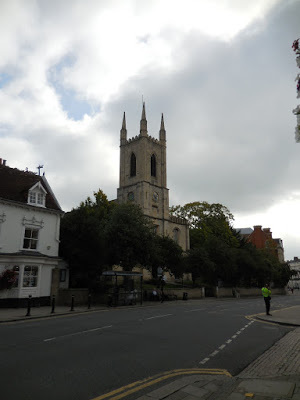
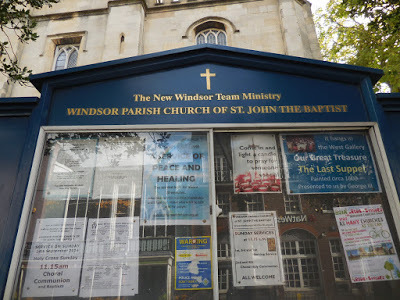
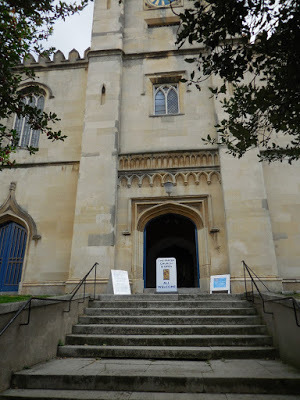
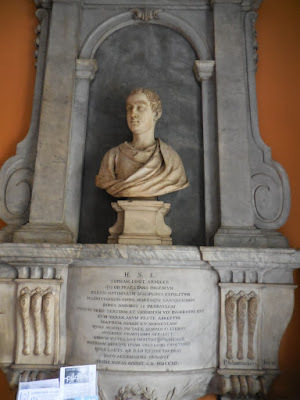 Memorial to Topham Foote, d. 1712, one of a prominent family in Windsor history
Memorial to Topham Foote, d. 1712, one of a prominent family in Windsor history
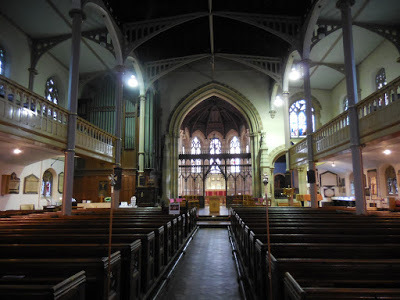
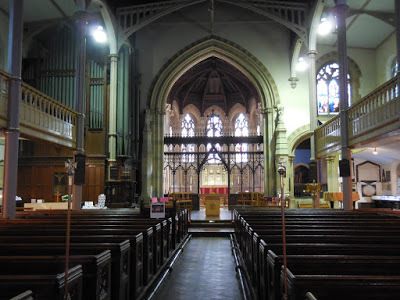
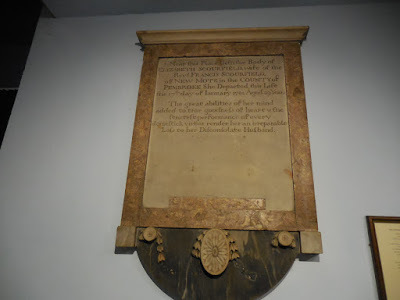 When the ancient church was rebuild in the early 19th century, the memorials were preserved.
When the ancient church was rebuild in the early 19th century, the memorials were preserved.
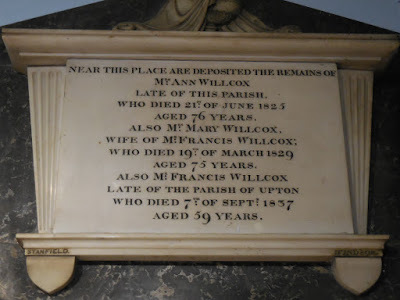
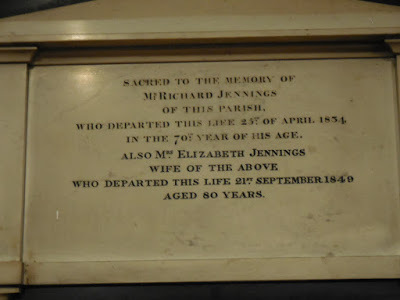
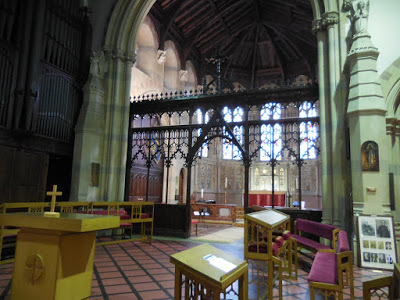
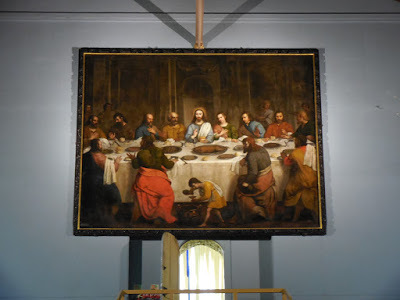 This Representation of The Last Supper was painted by Francis de Cleyn (c. 1582-1658), painter to King James I, also well known as a designer of Mortlake Tapestries. Holland House contains many of his works.
This Representation of The Last Supper was painted by Francis de Cleyn (c. 1582-1658), painter to King James I, also well known as a designer of Mortlake Tapestries. Holland House contains many of his works.
The painting was presented to St. George's Chapel in 1660 by the Bishop of Winchester, later presented to the Parish Church by George III. For more details, click here.
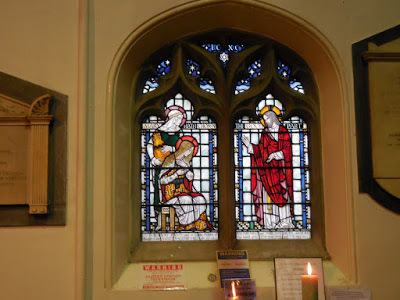
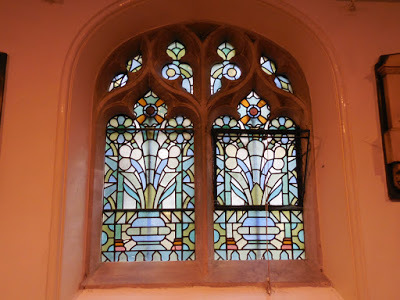 Beautiful stained glass
Beautiful stained glass
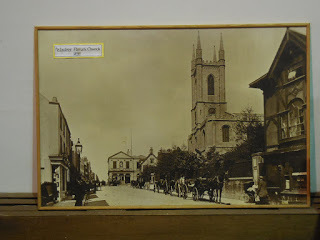 Old photo looking toward the Guildhall from in front of the church
Old photo looking toward the Guildhall from in front of the church
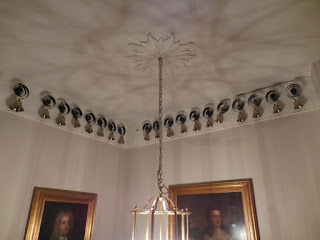 a large set of bells
a large set of bells
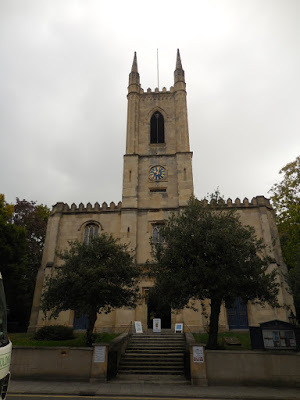
Not far along the High Street (toward the Great Park)from the Guildhall and Museum is the Parish Church of Windsor, St. John the Baptist. Victoria here, again, wandering the sights while Kristine languished in her sickbed.
I am always curious to get a look at pretty churches so I went in for a visit. Built in 1822, it followed the old Gothic Style of architecture. With enlargements, it can seat 1,000 people and is a frequent venue for weddings and other ceremonial events as well as parish functions.



 Memorial to Topham Foote, d. 1712, one of a prominent family in Windsor history
Memorial to Topham Foote, d. 1712, one of a prominent family in Windsor history

 When the ancient church was rebuild in the early 19th century, the memorials were preserved.
When the ancient church was rebuild in the early 19th century, the memorials were preserved.


 This Representation of The Last Supper was painted by Francis de Cleyn (c. 1582-1658), painter to King James I, also well known as a designer of Mortlake Tapestries. Holland House contains many of his works.
This Representation of The Last Supper was painted by Francis de Cleyn (c. 1582-1658), painter to King James I, also well known as a designer of Mortlake Tapestries. Holland House contains many of his works.The painting was presented to St. George's Chapel in 1660 by the Bishop of Winchester, later presented to the Parish Church by George III. For more details, click here.

 Beautiful stained glass
Beautiful stained glass  Old photo looking toward the Guildhall from in front of the church
Old photo looking toward the Guildhall from in front of the church a large set of bells
a large set of bells
Published on February 19, 2016 00:00
February 16, 2016
A FEW OF VICTORIA'S FAVOURITE SIGNS
Published on February 16, 2016 23:30
February 14, 2016
A LOOK AT VAUXHALL GARDENS
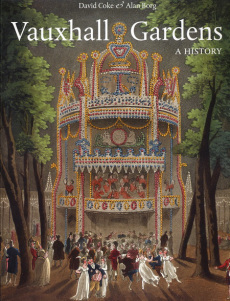
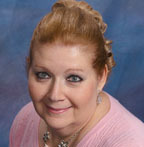
Recently, author Susana Ellis ran a 23 part series about the history of Vauxhall Gardens on her blog, based upon the fabulous coffee table book she aquired, above. Chock full of historical tidbits and images, the series is not to be missed by anyone interested in the Gardens or London history. You'll find Part One of the series here.
I'm sure we all wish that the Gardens still existed so that we could wander the grounds and buildings and imagine ourselves walking beside the notables who promenaded the lanes whilst listening to the bands and watching the magnificent illuminations. Personally, I would have loved to have been there for the Waterloo Celebrations. These days, it often takes a lot of imagination to be able to disregard the trappings of modern London in order to envisage the past. On a prior trip to London, I stood upon Hampstead Heath and gazed down upon the City proper, imagining what the place might have looked like in the dark of night, with footpads and highwaymen laying in wait for unlucky travellers foolish enough to cross the Heath on moonless nights. I also walked the grounds of Ranelagh Gardens, now an offshoot of the grounds of the Royal Chelsea Hospital. No Rotunda, alas, nothing left but the images one carries in the mind and the heart.
Fortunately, intrepid seekers of the remnants of Vauxhall Gardens can contact London Trails, a London based company that offers walking tours using routes that follow old maps. Their Vauxhall Gardens tour is on my bucket list.
Published on February 14, 2016 23:30
February 11, 2016
POST-TOUR: LITERARY WINDSOR
While Kristine slept...Victoria went wandering, finding a Tour of Literary Windsor on my agenda.
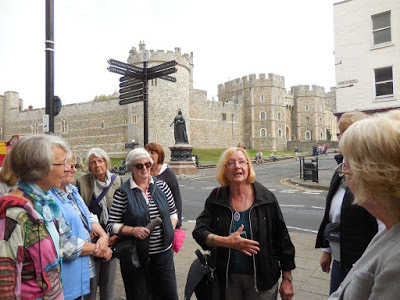
Queen Victoria was the first literary figure we discussed. The Queen not only wrote extensively; she was also an accomplished artist in water colors.
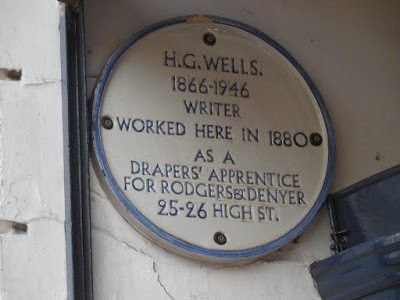
On the High Street we found a plaque honoring H. G. Wells who worked here in 1880.
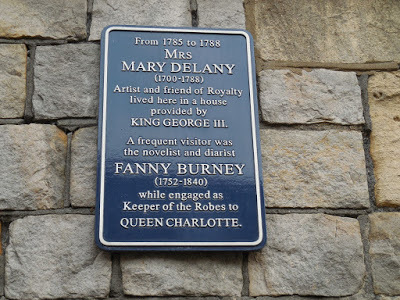
On a wall near the castle, a sign commemorates Mrs. Delaney, an artist, and Fanny Burney, noted novelist and playwright.
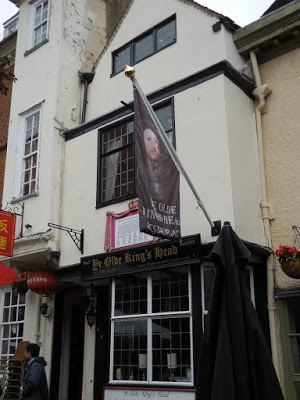
Ye Olde King's Head dates from the time of Henry VIII and was reputedly the home of Shakespeare while he wrote The Merry Wives of Windsor.
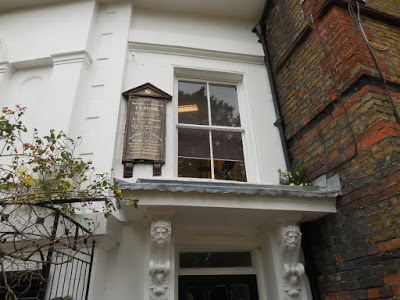
Above and below, home of poet and hymnist S. J. Stone (1836-1900). One of his most famous is "The Church's One Foundation," 1866
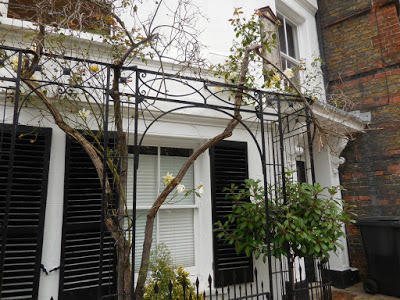
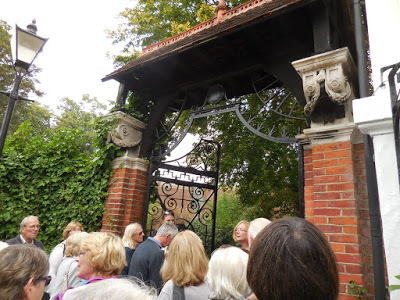
The tour at the gateway to the park Bachelors Acre which honors editor and publisher Charles Knight (1791-1873
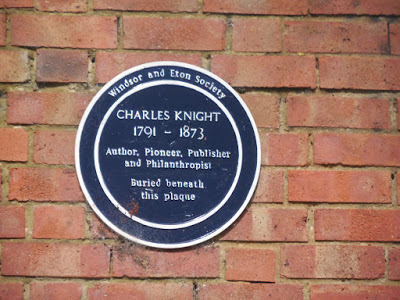
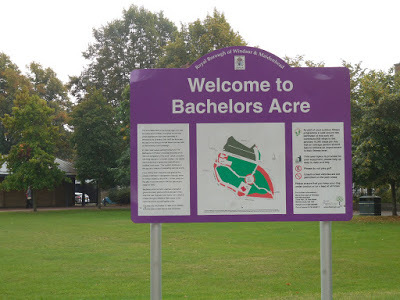 Map of the park
Map of the park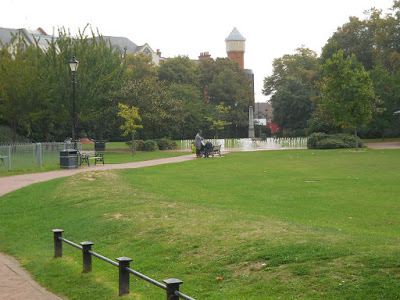 A quiet day in Bachelors Acres
A quiet day in Bachelors Acres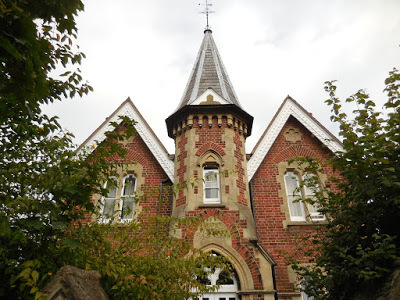
Above and below Joseph Chariott's House; the Victorian philanthropist built many almshouses in Windsor.
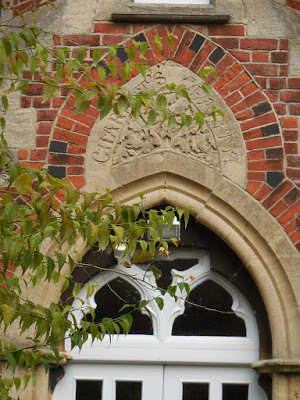
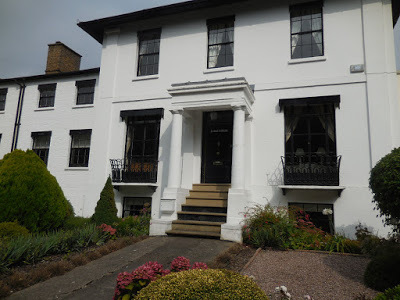
Our last stop was Oliphant House, residence of Margaret Oliphant, a 19th century novelist and historian who lived here in Clarence Crescent; she wrote more than 120 books.
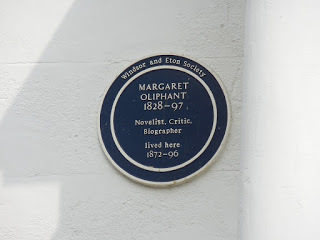
It was time now to pack up and depart Windsor, Kristine's misery not withstanding. We decided to take a taxi to our next stop in Hampstead- quite a long ride, but efficiently accomplished as we prepared ourselves for more adventures ahead.
Published on February 11, 2016 23:30
February 9, 2016
THE DUCHESS OF DEVONSHIRE AUCTION
This March, Sotheby's, London, will be auctioning items belonging to
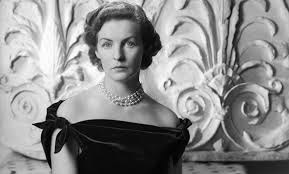
Deborah, Duchess of Devonshire: The Last of the Mitford Sisters
2 March | London
Born into English society as the youngest of the Mitford Sisters, Deborah, Duchess of Devonshire was unfailingly elegant yet down-to-earth. This March, Sotheby’s will offer more than 450 objects from her personal collection, including jewellery, works by artist friends like Lucian Freud, family photos and charming hen-related objects.
I admit here that I have always had a special affinity for this Duchess, as for her predecessor, Georgiana.
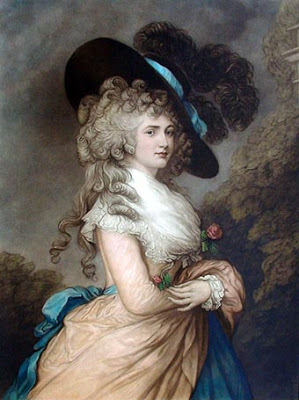
Both women lead spectacular lives, albeit for different reasons, but each was a star in her own right. I believe that their connections to Chatsworth House adds to my affections, as Chatsworth remains my personal favourite Stately Home.

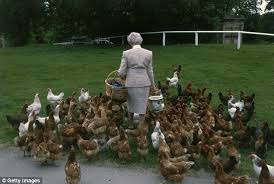
Still, you have to admire Deborah Mitford, who grew up in a stellar family and who married a minor member of the aristocracy, who ascended to the dukedom when his elder brother was killed in WWII. Through it all, the Duchess remained Debo to all - her down to earth, get it done mindset allowed her and the Duke to pull Chatsworth from the brink of bankruptcy and turn it into the most successful of British estates and a model for other members of the peerage who afterwards opened their own homes to the public. Through it all, the Duchess remained true to herself and to her love of country pursuits, including her involvemet in championing many breeds of British livestock, including her beloved hens, which can still be seen at Chatsworth. The Duchess was also an ardent fan of Elvis Presley.
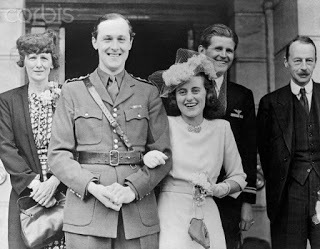
Deborah would never have become Duchess had the Duke's elder brother, William Cavendish, Marquess of Hartington, who was married to Kathleen "Kick" Kennedy, sister to the President, not died before him. You can read more about that chapter of Chatsworth history here.
For more background on Deborah, Duchess of Devonshire and the auction, you will find the article from the Daily Mail here.
And you will find a slideshow of limited items from the Sotheby's sale on their website here.
Published on February 09, 2016 23:30
February 8, 2016
DESIGN YOUR OWN WIG
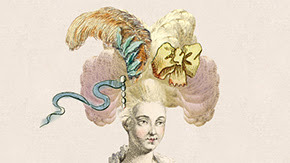
Use the Victoria and Albert Museum's interactive app to design your very own wig. Sculpt, decorate, powder and then share your masterpiece on social media.
Published on February 08, 2016 00:00
Kristine Hughes's Blog
- Kristine Hughes's profile
- 6 followers
Kristine Hughes isn't a Goodreads Author
(yet),
but they
do have a blog,
so here are some recent posts imported from
their feed.



















